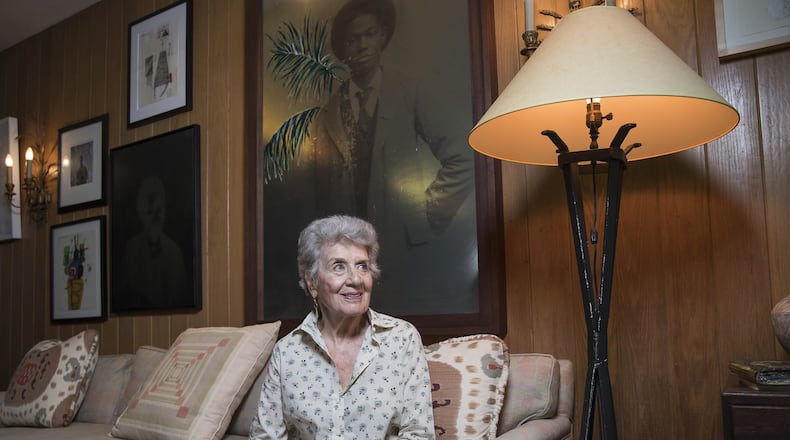In late 2014, Lucinda Bunnen, clad in jeans and a sunny yellow shirt, scooted around the Mason Murer Fine Art gallery in white socks. She smiled as she approached her photograph of a Cuban woman’s creased and weathered face under a bright red hair bow, a cigar clinched in one hand.
Bunnen, then 85 years old, had sold more of this photograph than any other image. The woman in the photograph is relatively well known; tourists often snap a photo of her posing while traveling in Cuba. But others don’t obtain what Bunnen caught in that singular, candid moment.
Credit: hpousner
Credit: hpousner
“I saw her and snapped the picture, " Bunnen said. “And it was that second, it was the moment when she was not posing.”
Bunnen, 92, born in New York on Jan 14, 1930, died Sunday night, according to family.
Over the decades, Bunnen captured a large and diverse array of images including landscapes — mainly trees — surreal compositions, portraits, building facades and scenes from her travels.
Bunnen was also a collector and philanthropist. Her collection included well-known photographers such as Ansel Adams. She was also celebrated here in a 2013 exhibition drawn from more than four decades of her giving to the High Museum of Art. Bunnen donated more than 1,000 photographs from her collection and established the museum’s first dedicated photography gallery.
“She’s really a remarkable woman in the way that she’s worn several hats and done it very gracefully,” said former High photography curator Brett Abbott. “She identifies as an artist, but she’s also been an incredibly important philanthropist, a visionary collector and a supporter of other artists’ work. …She was not just making photographs but collecting photographs and supporting the photographers and supporting museum photography at a time when photography was not well collected or well understood within the musuem context.”
Bunnen’s affinity for photography developed during a family trip to Peru in late 1969. She was turning 40 and didn’t want to celebrate with a party, but instead made plans to usher in the next decade with a family trip to remote areas of South America.
She made a silent Super-8 movie of the trip, capturing images of natives who had never seen outsiders before. After returning home from the Peruvian adventure, she signed up for the first photography class offered at Atlanta College of Art in 1970 and quickly established herself as a highly unconventional artist, seeing and capturing images others missed.
Her teacher saw Bunnen blossoming as a unique artist, and he encouraged her to keep going — and keep doing what she was doing.
“Some people decide they will photograph abandoned buildings in New York City, and that’s what they do for two years, " Bunnen said. “But I am open-minded. I am not looking for anything in particular. I am just looking.”
Bunnen keenly observed to seize the decisive moment — like when the clouds in the sky seemed to replicate the cotton balls in a field, or when a cow stood perfectly still in summertime in India near the banks of the Ganges River. She also created unique artistry by manipulating the images. In one instance, she discovered a handful of slides damaged by heat and moisture from storage. The surreal and swirling patterns in the images created by the damage gave her an idea. She piled up hundreds of unwanted slides left them out on her deck for nature to alter. After a few weeks in the elements, the slides took on a completely new look. Water, heat, and time created rich, psychedelic patterns, leaving only small clues into the original images.
Giving was in her genes: After selling his half of Sears, Roebuck & Co., her grandfather started the Manhattan-based Norman Foundation, which continues to support economic and environmental justice causes. Her LUBO Fund, which focuses on arts giving and equal rights, is an offshoot.
“I often refer to her as a kind of patron saint of photography in Atlanta and certainly the High,” said Abbott.
She is survived by three children: Robert L Bunnen Jr. of Atlanta and Maryland, daughter Belinda Bunnen Reusch (Ken), and daughter Melissa Bunnen Jernigan (James); eight grandchildren and one great-grandchild.
The Bunnen family will host a celebration of Lucinda’s life 11a.m. to 1 p.m. Saturday, April 2, at the Atlanta Contemporary, 535 Means Street. Attendees are invited to bring photos, mementos and other items reflecting your love for Lucinda. Dress is casual. In lieu of flowers, donations may be made to the High Museum of Art, the Hambidge Center, Atlanta Contemporary, or Museum of Contemporary Art in Georgia (MOCA GA).
About the Author
The Latest
Featured




